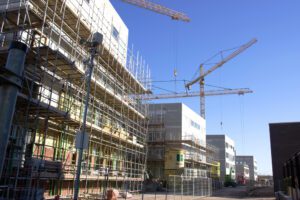Michael Shanly’s Commitment to Purposeful Development Realised in Chapel Arches

Can private development rebuild not just infrastructure, but also trust within local communities? It’s a deceptively simple question, but one that cuts to the heart of modern urban life.
Across the UK—and much of the world—town centres have hollowed out, their vitality sapped by shifting economies, online retail, and a pervasive sense of disconnection in how we live and work. In this context, developers are often viewed as villains, demolishing characterful spaces for profit-driven sprawl.
For decades, Michael Shanly has quietly built a legacy of transformative development that in many ways seems to reject the industry’s worst impulses. His work is rooted in practical solutions and a meticulous attention to detail that places purpose alongside profit. Chapel Arches, a landmark regeneration effort by Shanly Homes in Maidenhead, offers a compelling example of how private development can align with public interests.
The Start of Shanly Homes
As a boy in West London, Michael Shanly would cycle past a derelict house each day, its peeling paint and boarded-up windows a stark reminder of neglect. Most people would see decay and move on, but Shanly saw something else: potential. “One day, I want to buy that house and do it up,” he thought to himself. Where others saw something broken, he imagined what it could become.
The instinct to recognise potential and rebuild with purpose would define Shanly’s life. It guided him as a young man working two jobs to save enough to purchase his first property, the refurbishment and sale of which laid the foundation for his enduring legacy, Shanly Homes. His resourcefulness proved indispensable during the 1974 property crash, leading to the creation of Sorbon Estates—a long-term investment business built to endure the challenges of an ever-changing property market.
Shanly’s philosophy is equal parts pragmatism and vision. It rests on the principle that true development is not about speed or cost-cutting, but about crafting spaces with lasting value that meet the needs of their communities and endure for generations.
Revitalising a Historic Town
Maidenhead is the story of a town shaped by connectivity and adaptability. Its strategic location—first as a Roman settlement and later as a medieval hub on the Great West Road—made it a critical link for trade and travel. Over the centuries, it evolved from a riverside hamlet to a bustling coaching town, and later into a sophisticated Thameside resort with the arrival of the railway.
In more recent times, the town suffered a period of significant decline in the modern era. Decades of piecemeal redevelopment stripped away much of its historic character, replacing it with a “clone town” identity—dominated by chain stores and lacking unique local businesses. The disused Maidenhead Waterways that were once a defining feature of the town had become a symbol of neglect, falling into disrepair and diminishing the town’s sense of place.
Efforts to address Maidenhead’s need for revitalisation began in 2008 with the formation of the Partnership for the Rejuvenation of Maidenhead (PRoM), of which Michael Shanly is a founding member. The Chapel Arches project, developed by Shanly Homes, was introduced to address these challenges, focusing on revitalising the waterways and enhancing the town’s commercial and residential appeal.
Chapel Arches and Its Impact
Chapel Arches represents a significant shift in how town centres are reimagined. While many regeneration projects focus on flashy retail complexes or isolated housing developments, this initiative adopted a mixed-use approach to create a vibrant community hub with enduring appeal. Spanning three main phases—Waterside Quarter, The Picturehouse, and Chapel Wharf—the development has delivered 259 new homes and 30,000 square feet of commercial space to the heart of Maidenhead.
Chapel Arches has revitalised Maidenhead’s waterways, combining restoration with contemporary design to celebrate the town’s distinctive character. Around a large basin, which serves as the centrepiece of the development, are spaces designed to support both residential life and community activities. A newly constructed footbridge improves connectivity, while a 200-seat waterside amphitheatre, built by Shanly Homes, provides a communal space for public gatherings. Businesses such as Coppa Club and Bakedd artisan bakery have moved into the commercial units, helping to redefine the area as a destination in its own right.
The impact of Chapel Arches has been transformative. Nearly a million visitors now pass through the area each year, and the project has received significant accolades, including the RICS Regeneration Award and the Maidenhead Civic Society Design Award, for its role in positioning Maidenhead as a model for modern regeneration.
Development with Purpose
Chapel Arches illustrates how targeted investment and thoughtful design can transcend the act of constructing developments, delivering lasting change in communities. Large-scale, profit-driven projects often leave behind generic spaces that fail to reflect the unique needs of the communities they serve, but in concentrating efforts on towns like Maidenhead, Michael Shanly has challenged the prevailing narrative of globalised, one-size-fits-all development.
True regeneration goes beyond bricks and mortar, requiring developers to engage with a town’s history while also imagining what it could become—not just for the next quarter, but the next generation. Shanly’s work demonstrates this principle in action, reflecting a commitment to creating spaces that are not only functional but closely tied to the identity and needs of their surroundings. It’s an approach rooted in humility: the belief that development should integrate into a community, rather than impose upon it.
Chapel Arches demonstrates that when private enterprises approach development with intention they can move beyond the typical profit-driven model and become a catalyst for creating spaces where people can connect and thrive. Shanly has set a powerful example for the industry, offering a blueprint for development rooted in community impact and long-term vision. Adopting this mindset can see developers become deeper ingrained in the communities they shape, driving sustainable revitalisation.




